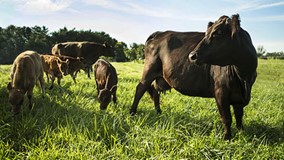In today’s beef business, cow/calf producers, backgrounders, feed yard operators and independent processors are working more together in aligned, value-added beef agreements to capture more revenue per head. In such arrangements, there’s both increased opportunity – and risk.
“Tighter margins are leading more producers to look for ways to capture revenue downstream,” said Nationwide Manager, MM Underwriting-Large Farm Peter LaMair. “There’s a lot of opportunities for producers in shifting from commodity beef to direct sales. But there are physical, contractual and financial risks that producers should consider when exploring direct sales.”
How aligned value-added beef agreements work
A common type of value-added beef agreement involves a small group of ranchers working together to align with a local processor or meat locker. In such an arrangement, the premium earned by producers is often based on proximity to the processor and end consumer. In many cases, these arrangements are based around a single rural community.
In cases like one in western Iowa, producer groups are connecting with regional beef processors to serve a larger consumer group. In some cases, this value-added beef is marketed based on specific characteristics. Producer premiums may be paid in exchange for meeting specific production criteria, like with grass-fed beef.
“In these arrangements, a processor will source cattle raised to certain specs, and producers are paid a premium based on those specs,” said Nationwide Business Program Management Senior Consultant Erin Cumings. “This makes it really important to make sure you understand and can meet your obligation when entering into an agreement like this.”
Knowing the risks and having the right insurance is key
Addressing your potential risks is an important first step in entering into any contracted agreement. LaMair said you should always include consulting your attorney and insurance agent. Contractual risk transfer is a big one to consider.
“You need to know what you’re getting into,” he said. “You have to be able to protect yourself from risks ranging from animal death loss to falling short of your contractual obligations. And you have to be able to document that you are meeting those obligations and are protected from risks that could otherwise be financially damaging to your operation.”
Cumings recommends attention to a phrase common in the insurance industry but not as well-known in the cattle business. “Care, custody and control” (CCC) should always be accounted for in contracts among ranchers, feeders, processors and any other players in a value-added beef system.
“Any contract should specify CCC at each step so everyone knows where their obligations start and end,” Cumings said. “You need to also make sure you have the right insurance coverage.” See your Nationwide livestock coverage options.
If you are looking to participate in a value-added aligned beef system, LaMair recommends taking the time to consult your attorney and Nationwide Farm Certified agent.
“It’s not always top-of-mind to have those conversations early in the process, but your attorney can help make sure you can meet your contractual obligations,” LaMair said. “Contact your agent to make sure that your policy structured correctly for any new operations you are considering.”
